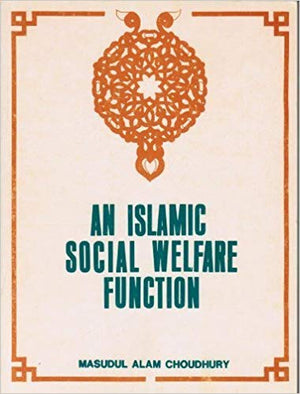



About
An Islamic Social Welfare Function - The main objective of this work is to develop a form of social welfare function for an Islamic economy.
SUMMARY OF CONTENT
Chapter I lays down the assumptions and properties of an Islamic welfare economy after a discussion of comparative welfare economics in a capitalistic and socialistic economic setting. These assumptions and properties of an Islamic welfare economy are then used to develop the axioms of social preference ordering in an Islamic state.
Chapter II develops a two-sector general equilibrium methodology for analyzing the pure economic and the pure non-economic components of total return from a social goods venture by an Islamic state. Through this two-sector general equilibrium methodology we shall establish the relationship between the two type of components of total returns from a social goods venture, as well as a model for the quantification of the two components.
Chapter III is devoted to the establishing of a mathematical form for the Islamic social welfare function in the pure economic and non-economic components of total returns from a social goods venture by an Islamic state.
Chapter IV shows that a special case of the Islamic social welfare function developed in Chapter III is a cost-benefit model for the evaluation of a social goods venture by an Islamic state. Zakah-induced welfare relationships between Zakah and earnings, and Zakah earnings and employment are established. These relationships, along with the cost-benefit model, are empirically evaluated using United Nations per capita income data for Saudi Arabia.
An Islamic Social Welfare Function - The main objective of this work is to develop a form of social welfare function for an Islamic economy.
SUMMARY OF CONTENT
Chapter I lays down the assumptions and properties of an Islamic welfare economy after a discussion of comparative welfare economics in a capitalistic and socialistic economic setting. These assumptions and properties of an Islamic welfare economy are then used to develop the axioms of social preference ordering in an Islamic state.
Chapter II develops a two-sector general equilibrium methodology for analyzing the pure economic and the pure non-economic components of total return from a social goods venture by an Islamic state. Through this two-sector general equilibrium methodology we shall establish the relationship between the two type of components of total returns from a social goods venture, as well as a model for the quantification of the two components.
Chapter III is devoted to the establishing of a mathematical form for the Islamic social welfare function in the pure economic and non-economic components of total returns from a social goods venture by an Islamic state.
Chapter IV shows that a special case of the Islamic social welfare function developed in Chapter III is a cost-benefit model for the evaluation of a social goods venture by an Islamic state. Zakah-induced welfare relationships between Zakah and earnings, and Zakah earnings and employment are established. These relationships, along with the cost-benefit model, are empirically evaluated using United Nations per capita income data for Saudi Arabia.
An Islamic Social Welfare Function
- Regular price
- $3.00
- Sale price
- $3.00
- Regular price
-
Couldn't load pickup availability



